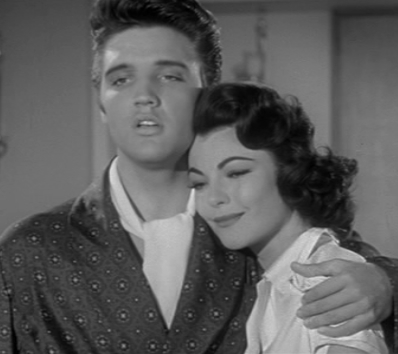 |
This is a file from the Wikimedia Commons. Information from its description page there is shown below.
Commons is a freely licensed media file repository. You can help.
|
| DescriptionElvis Presley and Judy Tyler in Jailhouse Rock trailer.jpg |
Screenshot of Elvis Presley and Judy Tyler from the trailer for the film Jailhouse Rock
|
| Date |
1957 |
| Source |
Jailhouse Rock trailer |
| Author |
Trailer screenshot |
Permission
( Reusing this file) |
According to Creative Clearance:
"Under the 1976 Copyright Act, all works of art, including trailers, are copyrighted as soon as they are created. Since the U.S. joined the Berne Convention (a copyright treaty) in 1988, no formalities (such as copyright registration with the Copyright Office or a copyright notice) are required to maintain one's copyright. However, in order to be able to make use of the various remedies found in the U.S. Copyright Act, such as infringement damages, injunctive relief, etc., it is important to register your work with the Copyright Office and place a copyright notice with the date on it. Therefore, trailers after 1976 will be copyrighted and will require permission for usage from the copyright holder whether or not they have a copyright notice or are registered with the Copyright Office.Most of the trailers prior to 1976 were created as new works, which contained new material (such as" Coming Soon" etc.) as well as scenes from the films they were advertising. The trailers did not contain copyright notices nor were they registered in the Copyright Office or the Library of Congress. Consequently, the new material at the very least went into the public domain. Many of these trailers also contained material that appeared to be from the movie but was actually shot directly for the trailer. That material, since it did not contain a copyright notice, would also fall into the public domain.
The major argument has been that the scenes from the film itself were protected by the copyright on the complete film. However, one could argue that once you cut a clip from a film, it is a separate entity and without a complete and separate copyright and notice, it too becomes public domain by its publication. Because of this, most studio contracts have required licensees of clip material to copyright their productions so as to maintain the studio's copyright in the clip. Furthermore, trailers prior to 1960 offer an additional incentive, since under SAG rules, theatrical feature films prior to 1960 do not require residuals to be paid to actors, writer and directors when the entire film is broadcast. Consequently, writers and directors in clips and trailers do not have to be paid and actors do not have to be cleared or paid as long as the trailer clearly identifies the film on screen over the clip as it is played or it is identified verbally. This information is not contained in the SAG Code Book but can be obtained from a SAG representative via a telephone call."
Further Information
|
Licensing
| Public domainPublic domainfalsefalse |
 |
This work is in the public domain in that it was published in the United States between 1923 and 1977 and without a copyright notice. Unless its author has been dead for several years, it is copyrighted in jurisdictions that do not apply the rule of the shorter term for US works, such as Canada (50 p.m.a.), Mainland China (50 p.m.a., not Hong Kong or Macao), Germany (70 p.m.a.), Mexico (100 p.m.a.), Switzerland (70 p.m.a.), and other countries with individual treaties. See this page for further explanation.
|
|
File usage
The following pages on Schools Wikipedia link to this image (list may be incomplete):
SOS Children's Villages aims to make Wikipedia suitable for young learners. SOS Children believes education is an important part of a child's life. That's why we ensure they receive nursery care as well as high-quality primary and secondary education. When they leave school, we support the children in our care as they progress to vocational training or higher education. Why not try to find out more about sponsoring a child?



